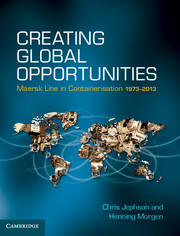Book contents
- Frontmatter
- Dedication
- Contents
- List of figures
- List of tables
- List of Economist Intelligence Unit data
- List of boxes
- Acknowledgements
- Glossary
- Prologue
- 1 ‘Per Aspera Ad Astra’
- 2 The Coming Revolution
- 3 The Decision
- 4 Building the Base (1978–1984)
- 5 Planning the Next Steps (1984–1987)
- 6 Laying the Foundations for Expansion (1987–1990)
- 7 The 1990s
- 8 The Acquisition Trail (1992–1998)
- 9 1999 A Year of Developments and Acquisitions
- 10 Into the New Millennium (2000–2005)
- 11 P&O NedLloyd (2005–2007)
- 12 A New Strategy (2008–2013)
- Epilogue
- Notes and References
- Index
7 - The 1990s
A Period of Transition
Published online by Cambridge University Press: 05 April 2014
- Frontmatter
- Dedication
- Contents
- List of figures
- List of tables
- List of Economist Intelligence Unit data
- List of boxes
- Acknowledgements
- Glossary
- Prologue
- 1 ‘Per Aspera Ad Astra’
- 2 The Coming Revolution
- 3 The Decision
- 4 Building the Base (1978–1984)
- 5 Planning the Next Steps (1984–1987)
- 6 Laying the Foundations for Expansion (1987–1990)
- 7 The 1990s
- 8 The Acquisition Trail (1992–1998)
- 9 1999 A Year of Developments and Acquisitions
- 10 Into the New Millennium (2000–2005)
- 11 P&O NedLloyd (2005–2007)
- 12 A New Strategy (2008–2013)
- Epilogue
- Notes and References
- Index
Summary
Globalisation accelerated in the 1980s and really started to take off in the 1990s following the fall of the Iron Curtain, which opened up the markets of Russia and East Europe, and, most dramatically, as China opened its door to free enterprise and foreign investment. Containerisation played an important role in opening these markets by providing an efficient freight transportation system.
‘50 Years of Containerisation’, US Journal of CommerceTwo documents from the end of 1989 provide an insight into the thinking of Maersk Line’s management at the time. The first was a McKinsey report entitled ‘Challenges in the 1990s’. Flemming Jacobs summarised the report in a note to Mærsk Mc-Kinney Møller and the A.P. Moller Group leadership: to win in the coming years ‘superior analytical skills would be essential; strong operational expertise would represent a necessary base platform; wide strategic flexibility would be needed; financial freedom would be required, with aggressiveness and a strong bias for action’.
The second was a short memo from Jacobs to Mærsk Mc-Kinney Møller and Ib Kruse. In it, he proposed the creation of a ‘vision’ for Maersk Line to build on the existing product differentiation and to guide the global organisation over the next few years. Jacobs cited intense competition from the Korean carriers as well as the Chinese COSCO, the reduced effectiveness of the conferences and the fact that none of the carriers was in a position to be a price leader.
- Type
- Chapter
- Information
- Creating Global OpportunitiesMaersk Line in Containerisation 1973–2013, pp. 188 - 219Publisher: Cambridge University PressPrint publication year: 2014



